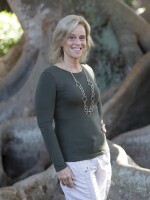An exhibition coming to the Ringling Museum in Sarasota, 'Reclaiming Home: Contemporary Seminole Art', showcases the work of Seminole, Miccosukee and mixed-heritage artists from Florida and the Seminole diaspora.
Seminoles were one of the five Southeastern nations who were forcibly relocated in the 19th century to present-day Oklahoma and beyond as part of the Indian Removal Act of 1830.
With more than 100 artworks by 12 artists, the range of media includes painting, photography, woodworking, textiles, beadwork and installation art.
Additionally, the exhibition also includes works on loan from Florida’s Ah-Tah-Thi-Ki Museum of Seminole culture and history, located on the Big Cypress Indian Reservation.
WUSF's Cathy Carter recently spoke Ola Wlusek, The Ringling Museum’s curator of Modern and Contemporary Art, about the show.
Ola, what should viewers expect when they visit this show?
One thing that's really important to understand is that this is an exhibition of contemporary Native art. So, for instance, what will not be on exhibition is artifacts or archaeological finds. It's not a historical exhibition. I really started working on this show by looking at who are some of the living Seminole and Miccosukee artists in the area working today, and some of them were extremely welcoming and I had the opportunity to visit their homes, visit their studios, and begin these conversations. It was really important for me to understand from them whether they were interested in the Ringling hosting their art.

Certainly, in recent years, there have been debates about representation within a cultural setting. So how do museums like the Ringling ensure a range of voices are being heard?
It's really a lot about thinking, how to work with Native American artists, like what set of questions should we as a museum be asking ourselves and really listen to what it is that they're telling us. There is traditionally a certain level of skepticism, because of the fraught history of what museums are. We're very much so colonial spaces, based on exploitation, and based on collecting and, you know, we have to think about the history of how museums started, who is allowed in, who isn't, who is represented, and who isn't, and on whose terms. So, there's definitely a lot of complex history that institutions such as the Ringling and others are grappling with. But for me, it was more thinking about, who are some voices that have not been represented yet, whether it is through exhibition making, or through collecting. So, for instance, I started my early conversations with one of the artists in the exhibition, her name is Jessica Osceola. She's an incredible artist based out of Naples on her ancestral homeland. And I'm very excited and proud to say that the Ringling acquired a work by her into the collection. It is the first Seminole piece of art to be acquired by this museum. And we're very proud and honored to include that work by Jessica in the upcoming exhibition as well.

So as a curator, would you say you approach your work any differently working with a specific group like Native American people or any other underrepresented group of artists?
I think the answer is yes. And I'm saying that in a very much so exciting way, because Indigenous and Native American cultures have a certain set of protocols and traditions and what one of the artists calls, cultural etiquette. One of the artists in the show, Pedro Zepeda, refers to that when he talks about his artwork and the traditional knowledge that his work is based on, and this idea of cultural etiquette is something that they're the stewards of as Native American people — and it's for white settlers like myself to learn about, to listen to, and to observe, but only on their terms in a way. So, I'm very excited to present this exhibition. I'm really hoping that for the Ringling in the long term, this is only the beginning and that the Ringling will be open to continuing to work with our local Native American artists and communities.
'Reclaiming Home: Contemporary Seminole Art', opens at the Ringling Museum of Art in Sarasota on Saturday with a free admission day for all. Artists from the exhibition will appear at the Museum with public programs beginning at 11am.
The show is on view through Sept. 4, 2023




